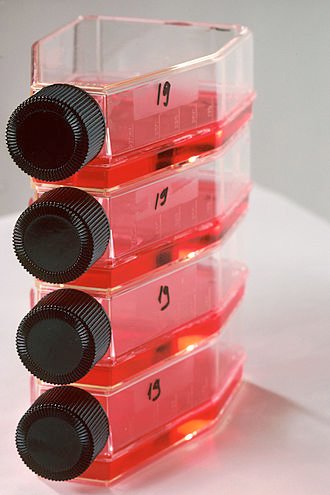
“Tissue culture is the technique of growing cells and tissues in an artificial medium separate from the organism.”
Table of Contents
What is Tissue Culture?
Tissue culture is a technique in which fragments of plants are cultured and grown in a laboratory. Many times the organs are also used for tissue culture. The media used for the growth of the culture is broth and agar.
This technique is also known as micropropagation. It has proved beneficial for the production of disease-free plants and increase plant yield in developing countries. It only requires a sterile workplace, greenhouse, trained manpower, and a nursery.
Oil palm, banana, eggplant, pineapple, rubber tree, tomato, sweet potato have been produced by tissue culture in the developing countries.
Types of Tissue Culture
Following are the different types of tissue culture techniques:
Seed Culture
In this culture, the explants are obtained from an in-vitro derived plant and introduced into a laboratory where they proliferate. The explant should be sterilized to prevent it from tissue damage.
Embryo Culture
This involves the in-vitro development of an embryo. For this, an embryo is isolated from a living organism. Both, a mature or an immature embryo can be used in the process. Mature embryos can be obtained from ripe seeds. The immature embryos are obtained from the seeds that failed to germinate. The ovule, seed or fruit is already sterilized, therefore, it does not need to be sterilized again.
Callus Culture
A callus is an unorganized, dividing mass of cells. When the explants are cultured in a proper medium, the callus is obtained. The growth of callus is followed by organ differentiation. The culture is grown on a gel-like medium composed of agar and specific nutrients required for the growth of the cells.
Organ Culture
In this, any organ of the plant such as shoot, leaf, can be used as an explant. A number of methods can be used for the organ culture, such as plasma clot method, raft method, grid method, and agar gel method. This method is used to preserve the structure and functions of an organism.
Protoplast Culture
It is a cell without a cell wall. A protoplast can be cultured using the hanging-drop method, or micro-culture chambers. In protoplast culture, a number of phases can be observed: development of cell wall, cell division, regeneration of a whole plant.
Other Types
- Pollen Culture
- Anther Culture
- Single Cell Culture
- Suspension Culture
- Somatic Embryogenesis
Steps of Tissue Culture
The steps of tissue culture are given below:
Initiation Phase
At this stage, the tissue is initiated into the culture. The tissue of interest is obtained, introduced and sterilized to prevent the process from any contamination.
Multiplication Phase
In this stage, the sterilized explant is introduced into the medium composed of growth regulators and appropriate nutrients. They are responsible for the multiplication of cells. This undifferentiated mass of cells is known as a callus.
Root Formation
The roots start forming. Plant growth hormones are added to initiate the root formation. Consequently, we obtain a complete plantlets.
Shoot Formation
The plant growth hormones for the formation of shoot are added and the growth is observed for a week.
Acclimatization
When the plant starts developing, it is transferred to the greenhouse to develop under controlled environmental conditions. It is finally transferred to the nurseries to grow under natural environmental conditions.
Advantages of Tissue Culture
Following are the various advantages of tissue culture technique:
- The plantlets are obtained in a very short time with a small amount of plant tissue.
- The new plants produced are disease-free.
- The plants can be grown throughout the year, irrespective of the season.
- A large space is not required to grow plants by tissue culture technique.
- The production of new varieties in the market place speeds up.
- This technique is being used for the production of ornamental plants such as dahlia, chrysanthemum, orchids, etc.
Importance of Tissue Culture
Tissue culture is very important in biology due to its wide range of applications.
Both plant and animal tissues can be used for culturing. For eg., animal tissue culture helps in preserving an organ or tissue.
Plant tissue culture may be used for genetic modification of a plant or simply increase its yield. the cells of the plants can be genetically altered to produce plants with desirable characteristics.
This technique utilizes the plant’s ability to rejuvenate the tissues rapidly. It produces exact copies of itself known as clones.
It is a technique of quickly producing plants without any tubers, seeds or bulbs.
It also helps in the conservation of plant biodiversity by the production of endangered plants

Tissue culture is the growth of tissues or cells in an artificial medium separate from the parent organism. This technique is also called micropropagation. This is typically facilitated via use of a liquid, semi-solid, or solid growth medium, such as broth or agar. Tissue culture commonly refers to the culture of animal cells and tissues, with the more specific term plant tissue culture being used for plants. The term “tissue culture” was coined by American pathologist Montrose Thomas Burrows.[1]
Contents
Historical use[edit]
In 1885 Wilhelm Roux removed a section of the medullary plate of an embryonic chicken and maintained it in a warm saline solution for several days, establishing the basic principle of tissue culture. In 1907 the zoologist Ross Granville Harrison demonstrated the growth of frog embryonic cells that would give rise to nerve cells in a medium of clotted lymph. In 1913, E. Steinhardt, C. Israeli, and R. A. Lambert grew vaccinia virus in fragments of guinea pig corneal tissue.[2] In 1996, the first use of regenerative tissue was used to replace a small length of urethra, which led to the understanding that the technique of obtaining samples of tissue, growing it outside the body without a scaffold, and reapplying it, can be used for only small distances of less than 1 cm.[3]
Gottlieb Haberlandt first pointed out the possibilities of the culture of isolated tissues, plant tissue culture.[4] He suggested that the potentialities of individual cells via tissue culture as well as that the reciprocal influences of tissues on one another could be determined by this method. Since Haberlandt’s original assertions, methods for tissue and cell culture have been realized, leading to significant discoveries in biology and medicine. His original idea, presented in 1902, was called totipotentiality: “Theoretically all plant cells are able to give rise to a complete plant.”[5][6][7]
Modern usage[edit]
Main article: Cell cultureCultured cells growing in growth medium
In modern usage, “tissue culture” generally refers to the growth of cells from a tissue from a multicellular organism in vitro. These cells may be cells isolated from a donor organism (primary cells) or an immortalised cell line. The cells are bathed in a culture medium, which contains essential nutrients and energy sources necessary for the cells’ survival.[8] Thus, in its broader sense, “tissue culture” is often used interchangeably with “cell culture“. On the other hand, the strict meaning of “tissue culture” refers to the culturing of tissue pieces, i.e. explant culture.
Tissue culture is an important tool for the study of the biology of cells from multicellular organisms. It provides an in vitro model of the tissue in a well defined environment which can be easily manipulated and analysed. In animal tissue culture, cells may be grown as two-dimensional monolayers (conventional culture) or within fibrous scaffolds or gels to attain more naturalistic three-dimensional tissue-like structures (3D culture). Eric Simon, in a 1988 NIH SBIR grant report, showed that electrospinning could be used to produced nano- and submicron-scale polymeric fibrous scaffolds specifically intended for use as in vitro cell and tissue substrates. This early use of electrospun fibrous lattices for cell culture and tissue engineering showed that various cell types would adhere to and proliferate upon polycarbonate fibers. It was noted that as opposed to the flattened morphology typically seen in 2D culture, cells grown on the electrospun fibers exhibited a more rounded 3-dimensional morphology generally observed of tissues in vivo.[9]



